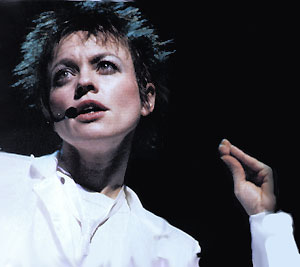 In honor of Ada Lovelace Day – an international day of blogging to celebrate the achievements of women in technology and science – we’d like to pay some respect to a few of the women of synthesis and electronic music.
In honor of Ada Lovelace Day – an international day of blogging to celebrate the achievements of women in technology and science – we’d like to pay some respect to a few of the women of synthesis and electronic music.
This is in no way comprehensive – it’s just intended to be a reminder of the important role women have played in electronic music.
Laurie Anderson is an performance artist and musician that achieved the impossible. In 1981, she scored a worldwide hit with her avant garde electroacoustic single O Superman.
How may hit singles can claim lyrics like this?:
So hold me, Mom, in your long arms.
So hold me, Mom, in your long arms.
In your automatic arms.
Your electronic arms.
In your arms.
So hold me, Mom, in your long arms.
Your petrochemical arms.
Your military arms.
In your electronic arms.
Anderson has also invented a variety of unique instruments for her performances, including a violin that uses a bow strung with magnetic tape.
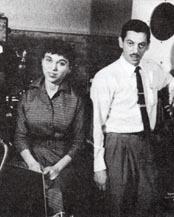 Bebe Barron, left, was a pioneer of electroacoustic music. Along with her husband Louis Barron, she created the pioneering electronic score for the film Forbidden Planet.
Bebe Barron, left, was a pioneer of electroacoustic music. Along with her husband Louis Barron, she created the pioneering electronic score for the film Forbidden Planet.
Forbidden Planet is recognized by many as the first electronic film soundtrack.
In the soundtrack liner notes, the Barrons explained their cybernetic approach to the soundtrack:
We design and construct electronic circuits which function electronically in a manner remarkably similar to the way that lower life-forms function psychologically.
In scoring Forbidden Planet – as in all of our work – we created individual cybernetics circuits for particular themes and leit motifs, rather than using standard sound generators. Each circuit has a characteristic activity pattern as well as a “voice”.
Later in life, Barron served on the board of the Society for Electro-Acoustic Music in the United States (SEAMUS)
Suzanne Ciani is best known now for her successful career in the world of new age instrumental music.
Earlier in her career, though, she worked with Don Buchla, and Ciani went on to help pioneer commercial electronic music.
In 1974 she formed her own company, Ciani/Musica. Using a Buchla modular synthesizer and other classic electronic music gear, Ciani created music and “sound logos” for the likes of Coca-Cola, Merrill Lynch, AT&T and General Electric.
Here’s Ciani explaining electronic music for kids, on 3-2-1 Contact:
http://www.youtube.com/watch?v=B_tjcshEurc
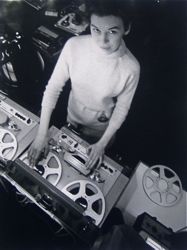 Where would electronic music be without Delia Derbyshire, right?
Where would electronic music be without Delia Derbyshire, right?
Derbyshire was an English musician and composer of electronic music and musique concrète.
She is best known for her work at the BBC Radiophonic Workshop and especially for her iconic electronic arrangement of Ron Grainer’s theme music to the British science fiction television series Doctor Who.
Eliane Radigue, below, is a French electronic music composer whose work, since the early 1970s, has been almost exclusively created on a single synthesizer, the ARP 2500 modular system and tape.
Around 1970, she created her first synthesizer-based music at NYU at a studio she shared with Laurie Spiegel on a Buchla synthesizer installed by Morton Subotnick.
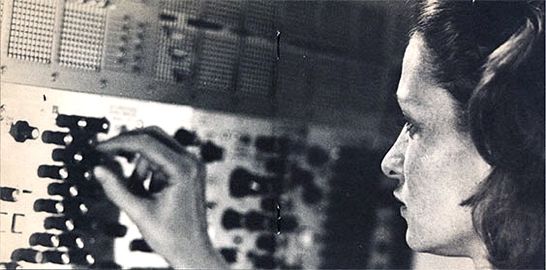
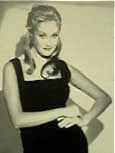 Dr. Fiorella Terenzi, right, is an Italian astrophysicist, author and musician, best known for taking recordings of radio waves from galaxies and turning them into music.
Dr. Fiorella Terenzi, right, is an Italian astrophysicist, author and musician, best known for taking recordings of radio waves from galaxies and turning them into music.
She’s been described “a cross between Carl Sagan and Madonna”, because of her glamorous style and interest in popularizing the science of astronomy through media.
She’s authored a CD-ROM, Invisible Universe, which combined music and poetry with astronomy lessons, and has released several albums of music that explore acoustic astronomy. She has collaborated with Thomas Dolby, Timothy Leary, Herbie Hancock, and Ornette Coleman.
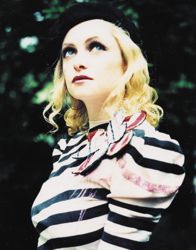 Alison Goldfrapp, right, along with Will Gregory, make up the electronica power duo Goldfrapp.
Alison Goldfrapp, right, along with Will Gregory, make up the electronica power duo Goldfrapp.
Starting with their debut album, Felt Mountain, Alison Goldfrapp quickly carved out her own style, singing, whistling, yodelling, playing the keyboards and playing the theremin on the unique album.
Since the Goldfrapp debut, the group’s style has changed almost as quickly as Alison Goldfrapp’s look.
On Black Cherry and Supernature, they left behind the soundtrack style of their debut album and jumped into glam synthpop. On their fourth album, Seventh Tree, they took a turn into more acoustic and folky territory.
Don’t expect Goldfrapp to settle down anytime soon. Their latest release, Head First, channels the dance music of the 80’s.
Thereminist Clara Rockmore was one of the most important early electronic music performers. She pioneered the performance technique of an instrument that was unlike any that had come before. In doing so, she also set a standard by which theremin performance is measured to this day.
In the video above, Rockmore plays Vocalise by Sergei Rachmaninoff.
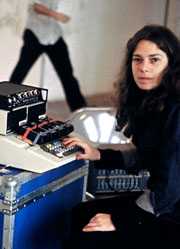 Laurie Spiegel is an American composer and performer, best known for her groundbreaking electronic-music compositions and her algorithmic composition software Music Mouse.
Laurie Spiegel is an American composer and performer, best known for her groundbreaking electronic-music compositions and her algorithmic composition software Music Mouse.
In the photo, right, by Joel Chadabe, Spiegel works on an early Apple computer.
Her Music For Obsolete Systems explores the aesthetics unique to music systems that are long considered obsolete.
She fell in love with synthesizers in the early days.
“The first time I saw one, a Buchla modular in Mort Subotnick’s old studio over the Bleeker Street Cinema, it was a mind blow and I fell madly in love with it,” says Spiegel. “After starting to work with it I began hearing everything differently, music, traffic noise… It was a revelation. Of course that was unlike most of today’s “synths”, not being based on a keyboard model or such concepts as notes. That was an instrument meant for working with the nature of sound itself.”
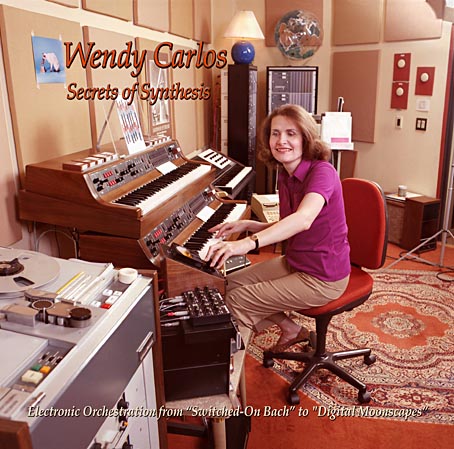 This is just a small sampling of some of the women that have shaped electronic music as we know it.
This is just a small sampling of some of the women that have shaped electronic music as we know it.
No list of women in electronic music would be complete, though, without Wendy Carlos.
Carlos (born Walter Carlos) has been one of the most influential electronic music composers and performers for over 40 years.
A few highlights of her career:
- Switched On Bach – this pioneering album of Moog arrangements of Bach pieces wowed millions, becoming on of the most popular classical albums of all time.
- Her score for Stanley Kubrick’s A Clockwork Orange showed that she could do equal justice to Beethoven.
- Her double album Sonic Seasonings, which combined recordings of nature sounds with synthesized ones, predicted the rise of ambient music.
- Her score for Tron combined orchestra, organ, chorus and a variety of electronics.
- On Beauty in the Beast, Carlos explored her interest in alternate tunings. For this album, she created new scales and explored them with original electronic compositions.
Who are some of the other women in electronic music that you think have been really influential?
Leave a comment with your thoughts!

"laura anderson"
:s
LAURIE Anderson…
I remember seeing Laurie Anderson on her 1990 tour. First concert I went to without parental supervision (followed, strangely enough, by Depeche Mode and Skinny Puppy later that same year… never thought of her as a gateway drug before)
I never even knew she was married to Lou Reed (as of 2008)… what a strange album that would be.
No love for Daphne Oram? Delia may be the cute one who did Dr. Who, but Oram was responsible for the creation of the Radiophonic Workshop in the first place, and invented an entirely new synthesis technique and recording medium to boot.
any list about women on synths should at least mention Takako Minekawa.
Two other women that come to mind are Tara Busch and Laura Escude. I escpecially appreciate that they give back to the electronic music community.
Mark
I'd like to see Pauline Oliveros and Maryanne Amacher on this list as well.
I'd like to see Pauline Oliveros and Maryanne Amacher on this list as well.
I especially like that they are espicy!
No Delia Derbyshire? Dr. Who!
My mistake! My RSS reader only caught half of it somehow.
Ruth White! Maggi Payne!
Hi!
We have coincidentally recently written a song about Ada Lovelace and were inspired by Ada Lovelace Day and indeed this article to post our song online.
Check out the song and more info here:
http://soundcloud.com/virul3nt/the-crystalline-ef…
Cheers,
-Pete
Hi!
We have coincidentally recently written a song about Ada Lovelace and were inspired by Ada Lovelace Day and indeed this article to post our song online.
Check out the song and more info here:
http://soundcloud.com/virul3nt/the-crystalline-ef…
Cheers,
-Pete
Annie Lennox likely deserves mention as the first female synthpop singer.
Aside from the two Human League ladies (both back-up), I don’t think there were any synthpop female singers before her.
Kate Bush, Gillian Gilbert, Anne Dudley…
Daphne Oram?